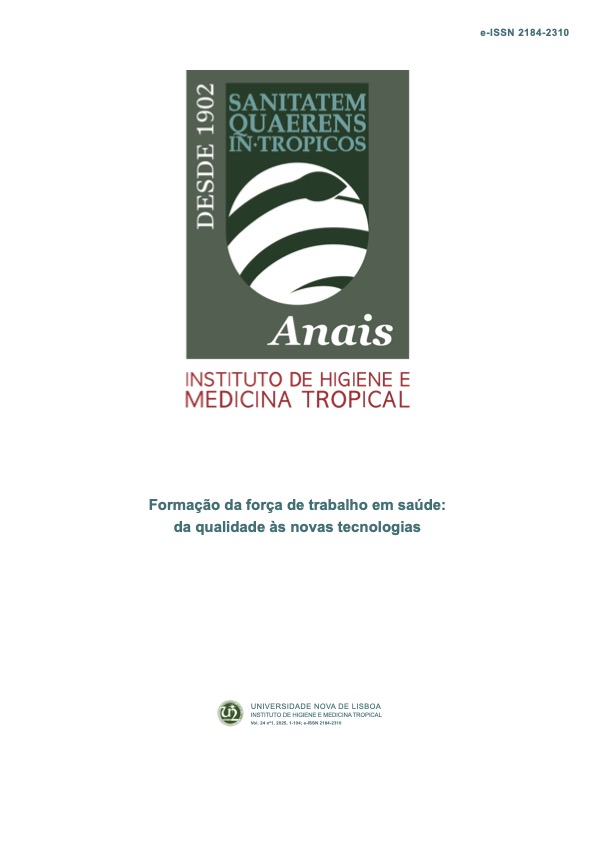Biomedicine and Artificial Intelligence in Postgraduate Education in Health Sciences in Angola
Abstract
The scientific and technological evolution of contemporary medicine demands a new profile of professionals: up-to-date, ethical, multidisciplinary, and prepared to integrate biomedical knowledge with digital tools such as artificial intelligence (AI). NOVA University of Lisbon, Agostinho Neto University from Luanda and Katyavala Bwila University from Benguela have been adapting their educational programmes, positioning biomedicine as a central pillar in training doctors and other healthcare professionals. This commitment includes promoting biomedical and translational research and adopting evidence-based practices essential for addressing societal needs and the growing complexity of health systems.
Downloads
References
Straus SE, Glasziou P, Richardson WS, Haynes RB. Evidence-Based Medicine: How to Practice and Teach EBM. 5th ed. Elsevier, 2018.
Ginsburg GS, Phillips KA. Precision medicine: from science to value. Health Aff (Millwood), 2018;37(5):694–701.
Viveiros M. O ensino das ciências médicas e biomédicas no Instituto de Higiene e Medicina Tropical – A contextualização histórico-pedagógica. An Inst Hig Med Trop. 2018;11:178–80. doi:10.25761/anaishtml.233
Ferreira AVL, Presta M, Simões CFG, Santos MR. Desafios da educação médica e da investigação em saúde no contexto de Angola [Challenges in medical education and health research in Angola]. Revista Brasileira de Educação Médica 2014; 38(1):133-141. https://doi.org/10.1590/S0100-5502201400100018
Ferrinho F, Daniel-Ribeiro GT, Ferrinho R, Frontera I. Building-blocks to develop one health systems. One Health. 2023 Aug 25;17:100624. doi:10.1016/j.onehealth.2023.100624.FMID.38024263
Rajpurkar P, Chen F, Banerjee O, Topol EJ. AI in health and medicine. Nat Med. 2022;28:31–8. doi:10.1038/s41591-021-01614-0
Fragata J. From Life Molecules to Global Health. 1ª ed. Lisboa: Principia Editora, 2021.
Fonseca M, Oliveira B, Carreiro-Martins P, Neuparth N, Rendas A. Revisiting the role of concept mapping in teaching and learning pathophysiology for medical students. Adv Physiol Educ. 2020;44(3):475–81. doi:10.1152/advam.00020.2020
Dickinson BL, Gibson K, VanDerKolk K, Greene J, Rosu CA, et al. "It is this very knowledge that makes us doctor": an applied thematic analysis of how medical students perceive the relevance of biomedical science knowledge to clinical medicine. BMC Med Educ. 2020;20:1–11. doi:10.1186/s12909-020-02251-w
Lutucuta S. Primeiro MBA de gestão de saúde arrancou com 40 directores hospitalares. Ver Angola [Jornal online]. 2023 Jan Consultado em 1 Abr 2025. Disponível em: https://www.verangola.net/va/pr/012023/Saude/34241/Primeiro-MBA-de-gest%C3%A3o-de-sa%C3BAAde-arrancou-com-40-directores-hospitalares.htm
Lobo LC. Inteligência artificial, o Futuro da Medicina e a Educação Médica. Rev Bras Educ Med. 2018;42(3):3–8.
Whitelaw S, Mamas MA, Topol E, Van Spall HGC. Applications of digital technology in COVID-19 pandemic planning and response. Lancet Digit Health. 2020;2(8):e435-40. doi:10.1016/S2589-7500(20)30142-4
Futoma J, Simons M, Panch T, Doahs Veder E, Cel LA. The myth of generalisability in clinical research and machine learning in health care. Lancet Digit Health. 2020;2(9):e489-92. doi:10.1016/S2589-7500(20)30186-2
Steinberg E, Jung K, Fries JA, Corbin CK, Pfohl SR, Shah NH. Language models are an effective representation learning technique for electronic health record data. J Biomed Inform. 2021;113:103637. doi:10.1016/j.jbi.2020.103637
Lee Flood and Drug Administration. Artificial intelligence and machine learning (AI/Mi). - Enabled Medical Devices. 2023 Jun 15 [consulted on 20 dec 2023]. Disponivel em: https://www.fda.gov/medical-devices/software-medical-device-samd/artificial-intelligence-and-machine-learning-aiml-enabled-medical-devices
Krishnan R, Rajpurkar P, Topol EJ. Self-supervised learning in medicine and medicine. Nat Biomed Eng 2022;6(12):13456-52. doi:10.1038/s41531-022-00914-1
Radford A, Kim JW, Hallacy C, Ramesh A, Goh G, et al. Learning transferable visual models from natural language supervision. In: Proceedings of the 38th International Conference on Machine Learning. 2021 Jul;139:8748-63. Available from: http://proceedings.mlr.press/v139/radford21a/radford21a.pdf
Brown T, Mann B, Ryder N, Subbiah M, Kaplan JD, Dhariwal P, et al. Language models are few-shot learners. Nat Neural Inf Process Syst. 2020;33:1877-1901. Available from: https://proceedings.neurips.cc/paper_files/paper/2020/file/1457c0d60fcb49674f8bfb8ac4f2f6fa-Paper.pdf
Chakraborty C, Pal S, Bhattacharya M, Dash S, Lee SS. Overview of Chatbots with special emphasis on artificial intelligence-enabled ChatGPT in medical science. Front Artif Intell. 2023;6:1237704. doi:10.3389/frai.2023.1237704
Bruno D. Error theory, unbelievability, and the normative objection. J. Ethics Soc. Philos. 2020, 177(9), 2737-55. doi:10.26556/jesp.v17i2.908
Yang HS, Wang F, Greenblatt MB, Huang SK, Zhang Y. AI Chatbots in Clinical Laboratory Medicine: Foundations and Trends. Clin Chem. 2023;(6)(11):1238-46. doi:10.1093/chinchem/hvad106
Acosta JN, Falcone CJ, Rajpurkar P, Topol EJ. Multimodal biomedical AI. Nat Med. 2022 Sep;28(9):1773-84. doi:10.1038/s41591-022-01981-z. PMID:36109635
Copyright (c) 2025 Anais do Instituto de Higiene e Medicina Tropical

This work is licensed under a Creative Commons Attribution 4.0 International License.





